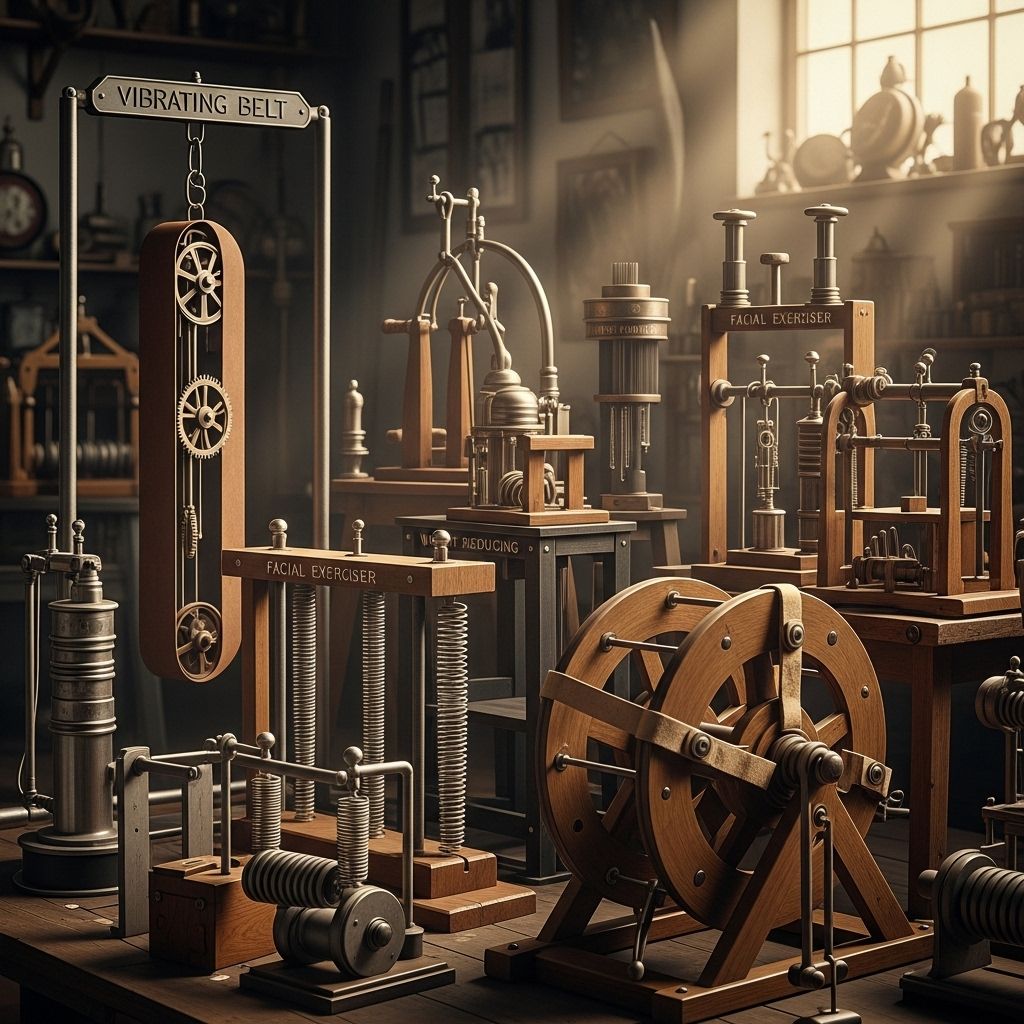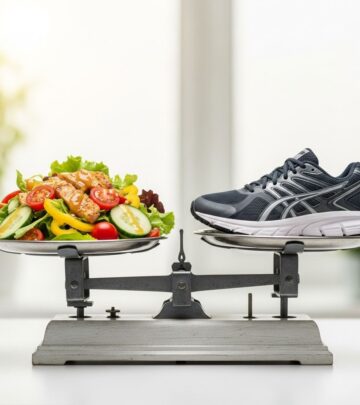Vintage and Bizarre Exercise Equipment: The Weird History of Fitness Machines
Step back in time to explore the strangest exercise machines and fitness fads that shaped the way people approached physical health over the last century.

Fitness may seem like a modern fascination, but the drive for physical health and the development of exercise equipment extend back more than a century. Starting in the early 1900s, inventors and entrepreneurs flooded the market with elaborate contraptions, promising everything from effortless fat loss to sculpted physiques. What we now recognize as efficient, scientifically-designed workout equipment evolved from an astounding array of quirky, and sometimes bizarre, inventions—some laughable, others bordering on torture devices.
Fitness Fever: The Rise of Home and Commercial Exercise Machines
Throughout the decades, hundreds of fitness methods and programs emerged, each touting the latest technology and promising quick results. These approaches led to the creation of exercise equipment that often appeared overly complex, unsafe, or simply ineffective. Yet, they captured the imagination of millions hoping for better health and slimmer bodies.
- Early 20th Century: Fitness was largely about amusement and social sport, often happening in local gyms, women’s parlors, or health clubs.
- 1930s–1950s: Mass media advertising encouraged the use of machines that promised to shake, roll, or squeeze your fat away with minimal effort.
- 1970s Boom: A leap in home-based fitness equipment led to widespread domestic exercise and the birth of the modern home gym.
Vibrating Exercise Belts: Shake the Fat Away
Among the earliest and most recognizable inventions was the vibrating exercise belt. Despite dubious results, these devices gained enormous popularity—especially in the 1930s and 1950s. The concept was simple yet sensational: Strap the vibrating belt around your waist, hips, or thighs, switch it on, and let the rapid oscillations “loosen” fat without breaking a sweat.
- The vibrating belt dates back to the 1800s but achieved fame in the mid-20th century.
- Advertising claimed users could lose weight while watching TV or napping.
- The device was designed to fit nearly any body type and could be used on various areas for “spot reduction.”
- Celebrity endorsements and health club demonstrations drove demand.
It wasn’t long before the medical community and skeptical users realized these machines offered little more than a temporary jiggle.
The Slendo Massager and Spring-Loaded Devices
Following the popularity of the vibrating belt, other inventors introduced spring-loaded and rolling machines. The Slendo Massager, for instance, resembled a cage made of coiled springs. Users would climb inside and the springs would roll over problem areas—usually stomach, hips, and thighs—to “shake away” fat with a different type of mechanical motion.
- Devices often looked more like torture instruments than health aids.
- Early advertisements depicted eager users undergoing treatments they clearly did not enjoy.
Human Hamster Wheels: Amusement or Exercise?
One especially striking invention was the human hamster wheel. Its origins date back to the early 20th century, where it found use both as a playful amusement and as a serious form of exercise. The participant would step into the large circular structure, using core strength and balance to keep the wheel turning.
- The hamster wheel served as an alternative to traditional treadmills.
- Gymnasiums occasionally featured these for group fitness and fun.
- Maintaining balance and momentum was a workout for both the core and legs.
While this odd piece of equipment may seem outlandish today, the human hamster wheel survives in modern times as an eccentric, alternative cardio workout.
The Gyro Wheel and Rotational Exercise Equipment
Another fascinating device was the gyro wheel, a large gyroscope into which a person was fastened. The wheel then spun and flipped the user in every direction, the motion intended to enhance circulation, cardiovascular strength, and balance. While the real physical benefits were debatable, it was certainly an unforgettable experience.
- Inventors marketed gyro wheels toward thrill-seekers and fitness clubs.
- Circulation and muscle stimulation were claimed as significant benefits.
Bongo Boards: The Seesaw for Solo Balance Training
Balance and coordination became the next frontier in at-home fitness. The bongo board—a simple piece of wood poised atop a roller—was promoted as an innovative way to sculpt your body and refine coordination. By teetering from side to side, users practiced keeping their equilibrium, which supposedly led to greater fitness.
- The bongo board rose to fame in the 1950s.
- It challenged stability, proprioception, and lower body strength.
- Marketed as perfect for home use and group demonstrations.
Las Picas: Twisting, Turning, and Full-Body Movement
Las Picas entered the scene in the late 1960s—a strange apparatus featuring two movable poles attached to a small box, inviting users to experiment with full-body stretches and twists. The flexibility of the device allowed for creative movements, though the benefits were as elusive as the techniques themselves.
- Emphasized bending, stretching, and mobility exercises.
- Appealed to those wishing to “contort every which way.”
Wooden Treadmills and the Evolution of Cardiovascular Equipment
Cardiovascular exercise became a staple of physical health with the introduction of the treadmill. Originally invented in 1818, treadmills featured wooden slats and large rolling drums, sometimes intended for prison labor before finding fitness application.
| Original Use | Key Features | Modern Evolution |
|---|---|---|
| Prison reform and physical punishment | Wooden steps, heavy handrails | Sleek design, electronic controls, shock absorption |
| Gymnasiums and sport facilities | Fabric belts, improved hand rests (1930s) | Digital readouts, heart rate monitors |
- The treadmill transformed into a home workout staple by the late 20th century.
- Lighter, sturdier, and far more user-friendly versions replaced earlier models.
- Nautical treadmills emerged, blending stationary cardio exercise and water sports.
Rowing Machines: From Titanic to Modern Gyms
The rowing machine has a long legacy as one of the earliest recognized methods for full-body exercise. Early rowers were very basic, but effective—elevating cardiovascular and muscular strength. Notably, even the Titanic gymnasium featured a rowing machine among its amenities.
- Movie stars like Helen Chadwick were photographed with these devices.
- Simplicity allowed for widespread use in clubs and homes.
- Modern iterations now employ advanced resistance and ergonomic design.
Multi-Pulley Contraptions: The Rise of Home Fitness
By the 1950s, exercise enthusiasts sought equipment that fit into the home. Complex pulley systems, tightropes, and stretches gained attention, often promising a full-body workout in a compact format. Devices ranged from suspension gear to folding benches, some of which remain in use today in modified forms.
- Easy setup and portability were major selling points.
- Allowed users to perform resistance and stretching exercises without large, expensive machines.
Resistance and Mechanical Training Machines: 1970s and Beyond
The late 20th century saw the innovation of commercial resistance machines, most notably the Nautilus line. These robust devices focused on targeted muscle engagement and systematic resistance, marking the transition from novelty fitness gadgets to science-backed strength training equipment.
- The Slender Bender mimicked a lawn chair for sit-up style workouts.
- The Prone Cycle worked the legs while lying down.
- Weight machines and stationary bikes began to dominate gyms and home fitness markets.
Vintage Outfits and Fitness Culture
Many historical photos of exercise equipment reveal not just technological oddities, but also the strange workout fashion of the era. From swimsuits and high heels in early treadmill ads to daily attire in local gyms, the visual culture of fitness was as eclectic as the machinery.
- Workout gear was limited to regular cotton clothes, as performance fabrics had not yet been invented.
- Hard-soled shoes and dresses were not uncommon gym attire.
From Fads to Fitness: Lessons from a Century of Exercise Equipment
The evolution of exercise machines is a testament both to innovation and human hope for effortless transformation. Modern gyms now favor scientifically-designed equipment built for safety and efficacy, but the relics of the past still fascinate us as reminders of a more experimental age.
- Bizarre devices highlight the powerful influence of marketing and cultural trends.
- Vintage equipment laid the groundwork for today’s flourishing fitness industry, despite questionable effectiveness.
- The nostalgia of retro gear fuels a market for collecting, restoration, and historical exhibitions.
Frequently Asked Questions (FAQs)
Q: Did any bizarre vintage exercise equipment actually work?
A: While some devices, like rowing machines and basic treadmills, did provide real physical benefit, many vibrating and spring-loaded machines were largely ineffective beyond creating sensation and amusement.
Q: Why were devices like the vibrating belt so popular?
A: The promise of effortless fat loss through passive exercise was appealing, and clever marketing capitalized on societal desires for convenience and quick results.
Q: Are any vintage exercise machines still used today?
A: Yes. Devices like treadmills, rowing machines, and resistance pulleys have evolved into modern gym staples, albeit with vastly improved design and science-based functionality.
Q: What made some exercise machines so dangerous?
A: Lack of ergonomic design, poor material quality, and mechanical unpredictability meant some devices posed significant risks, including pinched skin, falls, and muscle strains.
Q: Why do people collect or display vintage exercise equipment today?
A: Collectors and museums appreciate these relics for their historical significance, design eccentricities, and their representation of social and cultural shifts in health and wellness.
Conclusion
The history of exercise equipment is as strange as it is illuminating. From vibrating belts to human hamster wheels, these inventions reflect not only advances in technology but also the evolving relationship between society and personal health. Today’s sleek, ergonomic machines owe their existence to a century of innovation, hope, and more than a few hilarious missteps.
Read full bio of medha deb












